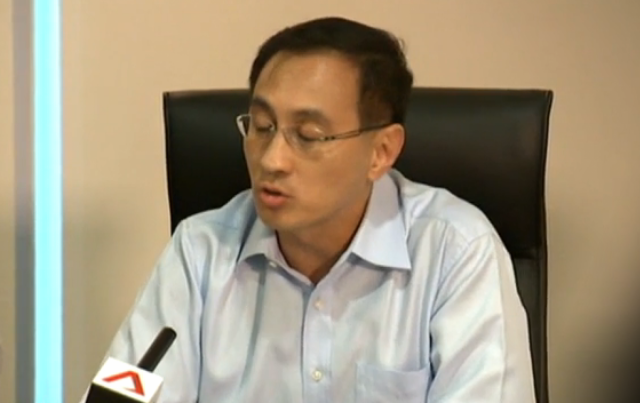We used to say, if you don’t know the answer to an exam question, you smoke your way through and hope you can convince the examiner that you somewhat know what you’re saying. In the army, you also smoke, to conceal, divert attention, or cause confusion. That seems to be what SMRT’s CEO is counting on.
At a press conference, here’s what SMRT CEO Mr Desmond Kuek explains:
Our records show, that the patrol man actually revisited the site that Saturday morning, before the particularly incident on 7th of July, and observed the leak. It wasn’t viewed then by the patrol man who was observing this to be something that so urgently needing repair. But we know circumstantially, there was a heavy downpour the night before, 7th July, could have, but again it’s not something which is conclusive, but these are examples of what we will be doing to try and see how we can step up and intensify some of our maintenance regimes.— Mr Desmond Kuek, CNA (photo above is a screengrab from CNA’s video)
SMRT is aware of the leak. But it was observed to be not in urgent need of repair. Or, perhaps, higher management determined that the repair was not urgent.
The bottom line, however, is that SMRT has failed. Why does Mr Desmond Kuek want to paint it like the patrol man was at fault?
Oh, then the exciting part is this, after pointing fingers at the patrol man, try to apportion some blame to mother nature. Blame on the rain, but knowing that that’s pretty much an excuse, qualifying it by admitting it’s not conclusive, yet still going ahead to offer this as the reason anyway.
A responsible leader could have just said: “We incorrectly assessed the leak to be non-urgent, and thus delayed the repair.” Simple.
The funny thing about Mr Desmond Kuek’s explanation above, about examples of how they are stepping up and intensifying their maintenance regimes, is that it is already on-going, That’s how the patrol man came to have observed the leak, which was not repaired, and that led to the massive disruption. In other words, SMRT is not going to do anything new.
I don’t want to get started on how his beating-around-the-bush is practically incomprehensible.
Now knowing the cause of the electrical fault that crashed the entire NSEWL on 7th July, SMRT says they’re working on rectification. The sooner the better, right? Possibly by the end of next month? By the end of 2015? No way. SMRT will take their own sweet time. It will be 2017. Q1 2017. Two more Merry Christmases. Two more Happy New Years. Two more Gong Xi Fa Cais.
Talk about managing expectations. We already had to wait years for sleeper replacements, only to now be further delayed by insulator replacements. In all likelihood, in 2016, we’ll hear that yet another thing needs replacement. It sounds like our train system will never be in good working condition.
On another note, I cannot understand why doing one work will have to preclude doing some other work. SMRT explains that there are limited maintenance hours, so they need to prioritise what gets done. But the train system is so big. Surely if you’re fixing something on one part of the system, you could fix something else in some other parts of the system? It’s not like while sleeper replacement is happening at Jurong East, you can’t change insulators at Yishun. This seems to be a trivial matter of scheduling. You probably need more manpower. Is this perhaps the crux of the problem? They only have a small finite pool of manpower, they refuse to engage more people, so this is the constraint that they are up against in scheduling and prioritising work on the train system?
The fault on 7th July is now finally diagnosed to be essentially an electrical short-circuit. A leak to ground. LTA and SMRT required the expertise of two international teams to point out an electrical short-circuit. I’m truly amused that SMRT did not have that knowledge in their own staff to figure this out themselves.
Another takeaway from the press conference is that SMRT is reconfiguring their 64P safety mechanism to trip at 200V instead of 136V, so that, basically, the system will be more tolerant of faults and thus trip less often. Please don’t touch any metal parts of the train or train station the next time you’re on the NSEWL, lest you become part of the circuit that keeps the train running. (Or perhaps, you’ll become part of the track fault.)

Public database of train service disruptions in Singapore – visualize on map and timeline (http://failrailsg.appspot.com/)
” Please don’t touch any metal parts of the train or train station the next time you’re on the NSEWL, lest you become part of the circuit that keeps the train running. (Or perhaps, you’ll become part of the track fault.) ”
You mean no commuters should touch the stainless steel hand railings at the door and throughout the length of the roof of every car/cabin of the train? lol, no laughing matter, this.